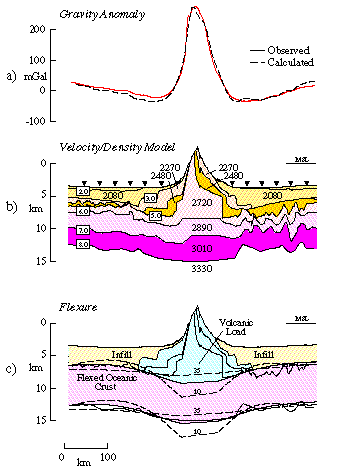Prof. Anthony B. Watts
Professor of Marine Geology and Geophysics
The deep structure of oceanic islands and seamounts
The structure of the oceanic crust and upper mantle beneath oceanic islands and seamounts provides constraints on the role of magmatic underplating in intra-plate settings, the thermal and mechanical properties of the oceanic lithosphere and, the role that crustal and upper mantle structure may play in swell formation.
We recently carried out a seismic reflection and refraction profile study of the structure of the crust and upper mantle in the region of Tenerife, the largest island in the Canary Islands archipelago. The seismic experiment, which was carried out onboard RRS Charles Darwin, was a joint project between Oxford and the University of Durham (UK) and the Institute of Earth Sciences (Barcelona). During the experiment, Darwin was equipped with a large-volume tuned air gun array, a 4.5 km long digital streamer and 6 Digital Ocean Bottom (OBS) seismometers. In addition, 5 recording stations on Tenerife were deployed by colleagues in Barcelona in order to record Darwin's sea shots.
Seismic data were acquired along a 550 km long "transect" which intersected the Canary Islands between Tenerife and La Gomera. The transect was oriented NE-SW in order to minimise the flexural effects from sediment loading at the Moroccan margin and maximise the effects of the islands.
The figure below shows an example of the seismic reflection profile data that was acquired in the flexural moat north of Gran Canaria. The left-hand edge of the profile shows the edifice of Tenerife. The profile shows that the moat is underlain by a thick sequence of sediments. At about 0.75 s below the seafloor at Common Depth Point (CDP) 5000 there is an angular unconformity which we interpret as the result of the infilling of the flexural moat that was caused by the volcanic load of Tenerife. The age of the unconformity is not known but, correlation with reflectors at ODP Site 953 suggest that it is about 8 Ma (Late Miocene). If this is correct, then it suggests that the sediments above the unconformity represent the infill of the flexural depression caused by the emplacement of the volcanic load of Tenerife. The sediments immediately below the unconformity most probably represents material that infilled Gran Canaria's flexural moat.

The seismic structure of the crust and mantle was verified by gravity modelling and then compared to predictions of simple elastic plate models (see figure to the right). The best fit between the depth to the top and base of the crust and the predictions is for a model in which Tenerife has loaded lithosphere with an elastic thickness of about 20-30 km. An elastic thickness of 10 km appears to produce too much flexure while a thickness of 35 km produces too little.
An important result from the seismic, gravity and flexure modelling is that the oceanic crust beneath Tenerife does not appear to be underplated by magmatic material. The island therefore differs from Oahu in the Hawaiian Islands where up to 4 km of underplated material has been reported. The absence of underplating maybe important to the problem of the origin of mid-plate swells. The Hawaiian Islands are associated with a high-amplitude topographic swell of about 1.5 km. The Canary Islands, however, are associated with only a modest swell. Future studies on the Cape Verdes Islands which also has a well developed swell (see figure below) would determine whether there is any relationship between magmatic underplating and swell formation.

Collaborators : Christine Peirce (Durham), Jenny Collier (Imperial), Pablo Canales (Woods Hole/Barcelona), Ingo Grevemeyer (IFM-GEOMAR)

